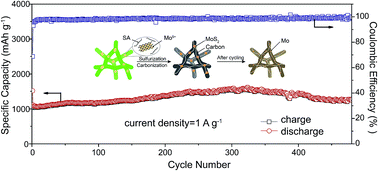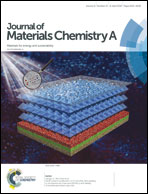Micron-sized encapsulated-type MoS2/C hybrid particulates with an effective confinement effect for improving the cycling performance of LIB anodes†
Abstract
Molybdenum disulfide (MoS2) holds great promise as an advanced anode material for lithium ion batteries, but suffers from poor electrochemical performance, especially cycling stability. Here, we report micron-sized particulates composed of encapsulated-type MoS2/C hybrid nanostructures which provide an effective confinement effect to soluble intermediate products during cycling reactions, offering a physically robust framework and locally stable sites for MoS2-based electrode reactions during the cycling process. The micron-sized MoS2/C exhibits a high specific capacity of 1343 mA h g−1 on average at 0.1 A g−1, excellent rate performance (929 mA h g−1 at 1 A g−1), and remarkable cycling stability with 1250 mA h g−1 retention at 1 A g−1 after 480 cycles. In addition, we further clarify the uniform redistribution of S and Mo in the carbon matrix during the decomposition of MoS2 nanoparticles which demonstrates the confinement effect of hybrid structures thus leading to an enhanced electrochemical performance, providing a meaningful suggestion for the rational design of sulfide- and selenide-based carbon hybrid electrodes for practical applications.



 Please wait while we load your content...
Please wait while we load your content...